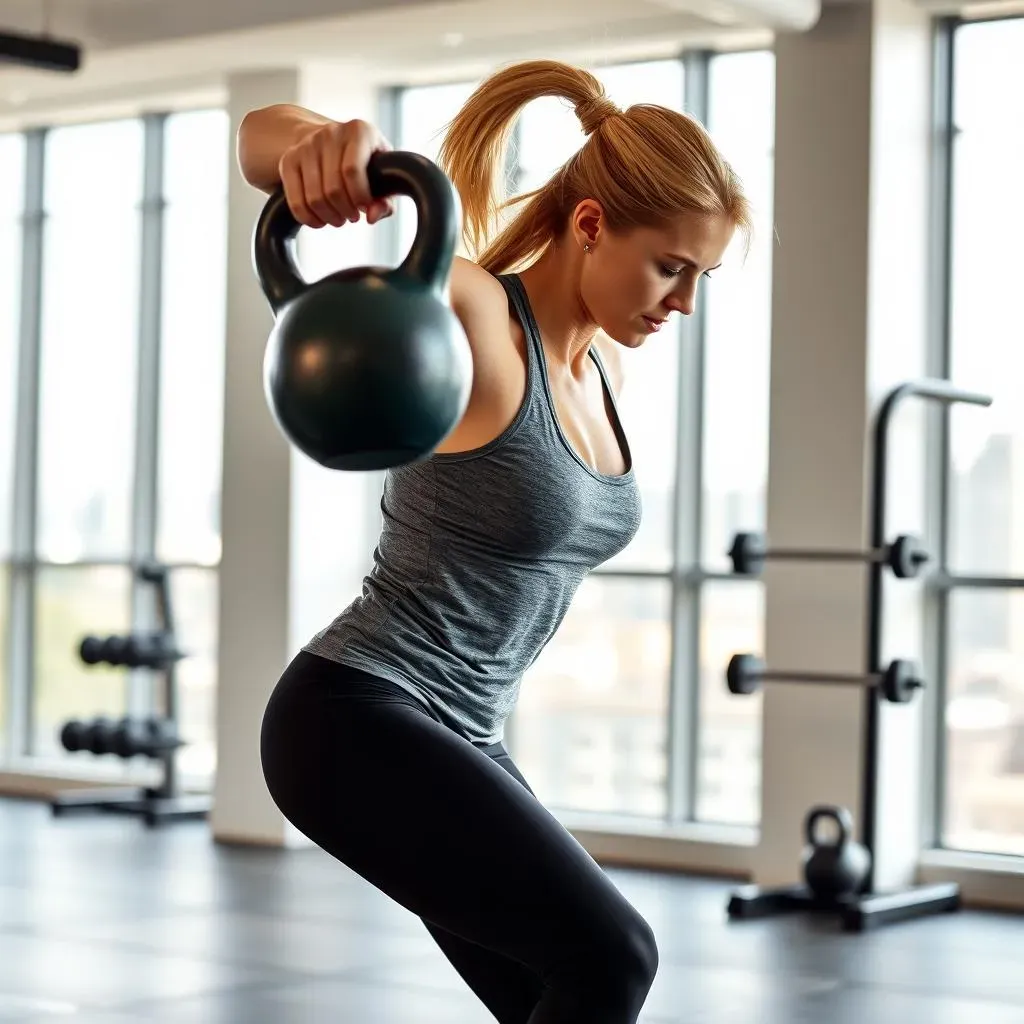Table of Contents
Ready to sculpt a stronger, more confident you? This beginner kettlebell workout program is your ticket to a fantastic fitness journey. Forget complicated gym memberships and confusing routines; we're keeping it simple and effective. Inside, you'll discover a complete guide designed to get you started safely and efficiently with kettlebells. We'll walk you through choosing the right kettlebell for your strength level, mastering fundamental techniques to prevent injuries, and building a 20-minute full-body workout you can easily fit into your day. This isn't just about getting fit; it's about building a sustainable fitness habit you'll actually enjoy. We'll show you how to progress safely, adding intensity and variety as you get stronger, and we’ll even give you a sneak peek at what comes next – more advanced kettlebell exercises to keep you challenged. So, whether you're a complete newbie or just looking to shake up your routine, this beginner kettlebell workout program is your perfect starting point. Let's get you moving!
Getting Started: Choosing Your Kettlebell and Mastering Basic Form

Getting Started: Choosing Your Kettlebell and Mastering Basic Form
Picking the Perfect Kettlebell
So, you're diving into the world of kettlebells – awesome! First things first: choosing your kettlebell. Don't get overwhelmed; it's simpler than you think. Think of it like picking the right-sized bike – too small, and you'll struggle; too big, and you'll fall over! Start with a lighter weight, maybe 8-12kg (18-26 lbs) for beginners. You can always upgrade later. Don't feel pressured to go heavy immediately; proper form is key! A good quality kettlebell will last you for years, so it's worth investing in one that feels comfortable in your hands. You can find a great selection of kettlebells online, or even at your local sporting goods store. Check out our guide to basic kettlebell exercises for more info!
Remember, this is a marathon, not a sprint! Starting slow and building a solid foundation is more important than lifting the heaviest weight. Focus on mastering the movements before increasing the weight. It’s far better to do 10 perfect reps than 20 sloppy ones. This will help prevent injuries and maximize your results. Plus, you'll feel more confident and empowered as you progress. We have plenty of resources to help you on your journey, like our beginner kettlebell workout guide.
Kettlebell Type | Pros | Cons |
|---|---|---|
Cast Iron | Durable, affordable | Can be bulky |
Competition Kettlebells | Precise weight, smooth finish | More expensive |
Mastering the Fundamentals: Proper Form
Okay, you've got your kettlebell – congrats! Now, let’s talk about form. Think of your body as a finely-tuned machine, and proper form is the high-octane fuel that keeps it running smoothly. Poor form can lead to injuries, so we’re going to take it slow and steady. Start with the basics: good posture, stable core, and controlled movements. Watch videos, read instructions, and don't hesitate to ask for help if you need it. There are tons of free videos online demonstrating the correct form for each exercise. A strong core is your secret weapon here, so make sure to engage those abdominal muscles throughout each movement. It might feel a little weird at first, but trust me, your body will thank you for it! Check out our beginner core workout for some extra core strengthening exercises.
Imagine a perfectly executed kettlebell swing – fluid, powerful, and controlled. That's the goal! Start with lighter weights, focus on your form, and gradually increase the weight as you become more comfortable. Consistency is key, even if it's just 10 minutes a day, three times a week. You’ll be amazed by the results you see. Remember, consistency beats intensity, especially when you're starting. For more ideas, check out our 10-minute kettlebell workout.
- Start light
- Focus on form
- Engage your core
- Be patient
A 20Minute FullBody Kettlebell Workout for Beginners: Exercises and Technique

A 20Minute FullBody Kettlebell Workout for Beginners: Exercises and Technique
Warm-up: Getting Your Body Ready
Before we dive into the workout, let's prep your body. A proper warm-up is crucial to prevent injuries and get your muscles ready to perform. Think of it as tuning up your engine before a race! Start with 5 minutes of light cardio, like jumping jacks or jogging in place. This increases your heart rate and gets the blood flowing. Then, do some dynamic stretches, focusing on your shoulders, hips, and back. These are movements that get your joints moving through their full range of motion. A few examples include arm circles, leg swings, and torso twists. Remember, a good warm-up is as important as the workout itself. Don't rush this part; take your time and listen to your body.
Five minutes of dynamic stretching is perfect for prepping your muscles for a kettlebell workout. Remember, we're not just warming up our muscles; we are also mentally preparing ourselves for the session ahead. This mental preparation is equally important. A calm and focused mind enhances performance and reduces the risk of injury. For additional warm-up ideas, check out our beginner kettlebell workout routine.
- 5 minutes light cardio
- Dynamic stretches (arm circles, leg swings, torso twists)
- Focus on mobility
The Workout: Six Exercises for a Full-Body Blast
Now for the fun part – the workout! This 20-minute routine hits all the major muscle groups, combining cardio and strength training for a fantastic full-body experience. We'll focus on six key exercises, each performed for 30 seconds with 15 seconds of rest between each exercise. Remember to maintain proper form throughout; quality over quantity is always the goal. We're building a strong foundation here, not trying to break any records on day one. Let's get those muscles working!
Here's the sequence: Kettlebell Swings (30 seconds), Goblet Squats (30 seconds), Turkish Get-Ups (30 seconds), Kettlebell Rows (30 seconds), Renegade Rows (30 seconds), and Plank (30 seconds). You can adjust the rest time based on your fitness level. Remember to breathe deeply and focus on the movement. If you need a visual guide, there are countless videos online demonstrating proper form. For more detailed instructions on each exercise, check out our guide to basic kettlebell exercises.
Exercise | Sets | Reps/Time | Rest |
|---|---|---|---|
Kettlebell Swings | 3 | 10-15 reps | 15 seconds |
Goblet Squats | 3 | 10-15 reps | 15 seconds |
Turkish Get-Ups | 2 | 5 reps per side | 15 seconds |
Kettlebell Rows | 3 | 10-15 reps per side | 15 seconds |
Renegade Rows | 3 | 5-8 reps per side | 15 seconds |
Plank | 3 | 30 seconds | 15 seconds |
Cool-Down: The Final Stretch
You've crushed it! Now it's time for a cool-down. This is just as important as the warm-up. Cool-downs help your heart rate gradually return to normal and reduce muscle soreness. Spend 5 minutes doing some static stretches, holding each stretch for 30 seconds. Focus on the major muscle groups you worked during your workout – your legs, back, shoulders, and arms. Static stretches involve holding a position for a period of time, gently lengthening the muscles. Some examples include hamstring stretches, quad stretches, and shoulder stretches. Don't bounce or force the stretch; let your muscles relax into the position. Remember, a proper cool-down is essential for muscle recovery and injury prevention.
Think of your body as a high-performance machine. Just like you wouldn't race a car without warming it up, you shouldn't end a workout without cooling down. This crucial step aids in muscle recovery and prevents stiffness and soreness the next day. By taking the time to cool down properly, you’re investing in your long-term fitness success. If you are interested in more advanced routines, consider our 4-week kettlebell program.
- 5 minutes of static stretching
- Hold each stretch for 30 seconds
- Focus on major muscle groups
Building Your Routine: Progression, Frequency, and Listen to Your Body

Building Your Routine: Progression, Frequency, and Listen to Your Body
Building Your Strength: A Gradual Approach
So, you've nailed the basics – fantastic! Now, let's talk about building your routine. Think of this phase as the exciting part of your fitness journey, where you see real progress. The key here is consistency and gradual progression. Don't try to do too much too soon. Instead, aim for regular workouts, building up your strength and endurance gradually. Start with 2-3 sessions per week, giving your body time to recover between workouts. As you get stronger, you can increase the frequency to 3-4 sessions per week, or even add an extra day for focused core work. Remember, your body needs rest to rebuild and grow stronger. Overtraining is a real thing, and it's counterproductive.
Listen to your body! It’s your best guide. If something hurts, stop! Don’t push through pain; that's a recipe for injury. Rest and recovery are crucial. Pay attention to how your body feels and adjust your routine as needed. Some days you might feel like a superhero, and others you might feel more like a slug. That's totally normal! Remember, this is a long-term commitment, not a sprint. Consistency is key, and listening to your body will help you stay on track and prevent injury. For additional workout ideas, check out our 30-minute beginner kettlebell workout.
- Start with 2-3 workouts per week
- Gradually increase frequency as you get stronger
- Listen to your body and rest when needed
Progression: Smartly Increasing the Challenge
As you get fitter, you’ll want to challenge yourself! But, how do you do this safely and effectively? There are a few ways to progress: increasing the weight of your kettlebell, increasing the number of reps or sets, or decreasing the rest time between sets. You could also add more challenging exercises to your routine. Remember, it's important to focus on maintaining good form as you increase the difficulty. Don't sacrifice form for weight or speed. If you find yourself struggling to maintain good form, it's time to reduce the weight or reps, or increase rest time. Focus on quality over quantity.
Think of it like climbing a mountain – you wouldn't sprint to the top, would you? You'd take it one step at a time, building up your strength and endurance along the way. Similarly, with your kettlebell workouts, gradual progression is crucial for long-term success. Small, consistent improvements are more sustainable than huge leaps that can lead to injury or burnout. For a structured approach, check out our 4-week kettlebell program for a structured plan.
Progression Method | Description | Considerations |
|---|---|---|
Increase Weight | Gradually increase the weight of your kettlebell. | Maintain good form. |
Increase Reps/Sets | Increase the number of repetitions or sets you perform. | Avoid overtraining. |
Decrease Rest Time | Reduce the rest time between sets. | Listen to your body. |
Add Exercises | Introduce new exercises to challenge different muscle groups. | Master the basics first. |
Beyond the Basics: Intermediate Kettlebell Exercises and Workout Ideas (check out our 4week program!)

Beyond the Basics: Intermediate Kettlebell Exercises and Workout Ideas (check out our 4week program!)
Adding Complexity: New Exercises to Master
Congratulations! You've built a solid foundation with the beginner exercises. Now it's time to level up your kettlebell game with some more challenging movements. Think of this as adding new tools to your fitness toolbox. We'll introduce you to exercises that work multiple muscle groups simultaneously, increasing both strength and coordination. This phase is all about refining your technique and pushing your limits in a safe and controlled way. Remember, proper form remains crucial even as you move to more advanced exercises. Don't rush this process; focus on mastering each exercise before moving on to the next.
Some great options to consider include Kettlebell Snatch, Turkish Get-Ups (with increased weight), and Windmills. These exercises require more balance, coordination, and core strength than the beginner movements. Start with lighter weights than you might think, and focus on maintaining perfect form. As your strength and confidence grow, you can gradually increase the weight to continue challenging yourself. Remember, progress is a journey, not a race. For a step-by-step guide to these more advanced techniques, check out our ultimate kettlebell exercises guide.
- Kettlebell Snatch
- Advanced Turkish Get-Ups
- Windmills
Designing Your Intermediate Workout: Structure and Intensity
Now that you have a wider range of exercises, let's talk about building a structured intermediate workout. Remember, consistency and gradual progression remain key. You can maintain a full-body routine, but now you can experiment with different exercise combinations and workout structures. Consider incorporating circuits, where you move quickly between exercises with minimal rest. This increases the intensity and cardiovascular challenge. You can also experiment with different rep ranges, sets, and rest periods to find what works best for you. Don't be afraid to get creative and find what keeps you motivated and engaged.
One effective approach is to choose 4-5 intermediate exercises, performing 3 sets of 8-12 repetitions for each. This allows you to focus on controlled movements and maximize muscle activation. Remember to incorporate a proper warm-up and cool-down into your routine. As you progress, you can increase the intensity by reducing rest periods, increasing the number of sets or reps, or incorporating more challenging variations of the exercises. Always prioritize good form over speed or weight. For a sample intermediate workout, check out our beginner full-body workout and adapt it to your new skill level.
Workout Structure | Description |
|---|---|
Full Body Circuit | Perform multiple exercises consecutively with minimal rest. |
Strength Focus | Focus on heavier weights and lower repetitions. |
Endurance Focus | Focus on lighter weights and higher repetitions. |
Taking it Further: Our 4-Week Intermediate Program
Feeling ready to take your kettlebell training to the next level? Then check out our comprehensive 4-week intermediate program! This structured program builds upon the foundation you've established, progressively challenging you with new exercises and workout variations. It provides detailed instructions for each exercise, ensuring you maintain proper form and maximize your results. The program includes a mix of strength and conditioning workouts, helping you build muscle, improve your cardiovascular fitness, and increase your overall strength and power. It's designed to help you safely and effectively progress beyond the basics.
Our 4-week program is more than just a collection of exercises; it's a roadmap to your fitness goals. It provides a clear structure, helping you stay motivated and consistent. It also includes progression guidelines, ensuring you challenge yourself appropriately without risking injury. We've designed it to be adaptable to your individual fitness level, allowing you to modify the exercises and workout intensity as needed. Ready to unlock your full potential? Click here to learn more about our 4-week kettlebell program and start your transformation today!